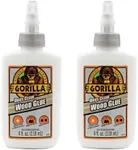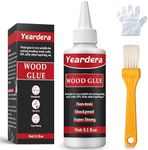Buying Guide for the Best Wood Glue For Cabinets
Choosing the right wood glue for cabinets is crucial to ensure a strong and durable bond. Wood glue is used to join pieces of wood together, and the right type can make a significant difference in the longevity and stability of your cabinets. When selecting wood glue, consider the type of wood, the conditions in which the cabinets will be used, and the specific requirements of your project. Here are some key specifications to consider when choosing wood glue for cabinets.Type of GlueWood glue comes in various types, including PVA (polyvinyl acetate), polyurethane, epoxy, and hide glue. PVA glue is the most common and is suitable for most indoor projects, offering a strong bond and easy cleanup. Polyurethane glue is waterproof and ideal for outdoor or high-moisture areas. Epoxy provides a very strong bond and is great for heavy-duty applications, while hide glue is traditional and reversible, making it suitable for antique furniture restoration. Choose the type based on your specific needs and the environment where the cabinets will be used.
Bond StrengthBond strength refers to how well the glue holds the wood pieces together. Higher bond strength is essential for cabinets that will bear weight or be subjected to frequent use. PVA glue typically offers sufficient bond strength for most cabinet projects, but for heavy-duty applications, epoxy or polyurethane glue may be better choices. Consider the expected load and usage of the cabinets to determine the necessary bond strength.
Drying TimeDrying time is the period it takes for the glue to set and reach its full strength. Fast-drying glues can speed up your project, but they may require precise application. PVA glue usually dries within 30 minutes to an hour, while polyurethane and epoxy can take longer. If you need to adjust or reposition the wood pieces, a longer drying time might be beneficial. Choose a drying time that fits your working pace and project requirements.
Water ResistanceWater resistance is crucial if the cabinets will be exposed to moisture, such as in kitchens or bathrooms. PVA glue is generally not waterproof, while polyurethane glue offers excellent water resistance. Epoxy also provides good water resistance but can be more challenging to work with. For cabinets in high-moisture areas, opt for a glue with strong water-resistant properties to ensure durability.
Ease of UseEase of use includes factors like application method, cleanup, and safety. PVA glue is easy to apply, non-toxic, and cleans up with water, making it user-friendly. Polyurethane glue requires careful handling and can be messy, while epoxy needs precise mixing and application. Hide glue can be more complex to use but offers unique benefits for specific projects. Consider your skill level and the complexity of your project when choosing a glue that is easy to work with.
ColorThe color of the glue can affect the final appearance of your cabinets, especially if the glue line is visible. PVA glue typically dries clear or slightly yellow, while polyurethane glue can dry to a brownish color. Epoxy can be tinted to match the wood color. Hide glue dries to a translucent amber. Choose a glue color that complements the wood and the finish of your cabinets to achieve a seamless look.




















